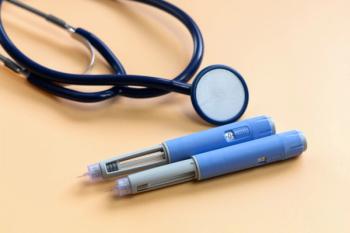
- March 2020
- Volume 88
- Issue 3
Standard Insulin Pen Needles Require Caution
Mandatory, scripted patient education and device demonstrations are vital to avoid harm.
Some patients who have not been educated about the proper use of disposable standard pen needles have experienced severe harm and died.1,2
In fact, the FDA has asked pen needle manufacturers to update the labeling and improve instructions for use.3 The request was issued to help inform patients that it is necessary to remove the inner needle cover on standard pen needles to administer the intended dose.
Unlike safety pen needles that are used most often in inpatient settings (figure 1), standard pen needles used in the home have outer and inner needle covers (figure 2), both of which must be removed prior to injection. After discharge from the hospital, patients may receive standard pen needles from their pharmacy and not know that the inner needle cover must be removed. If the inner cover of a standard pen needle is not removed, patients may not receive the medication.
The Institute for Safe Medication Practices has learned of another patient who was not aware of the need to remove the inner needle cover. The patient was admitted to a hospital with a blood glucose level of 57 mg/dL, a hemoglobin A1c level of 13.9%, a gait change, and slurred speech. It was discovered that the patient had not been removing the inner needle cover when using Lantus SoloStar (insulin glargine, Sanofi-Aventis US) and the NovoLog FlexPen (insulin aspart, Novo Nordisk). He described administering an entire Lantus SoloStar pen per day and using a napkin to soak up the insulin that leaked when injecting himself.
The day before presenting to the hospital, the patient had attended a diabetes self-management educational course and learned that he had not been removing the inner cover of the pen needle. After this realization, he removed the inner cover and injected the prescribed amount of insulin, which his physician had continually increased over the course of the year (Lantus 150 units in the morning and 156 units at bedtime; NovoLOG 80 units before each meal). The patient developed hypoglycemia after injecting the prescribed amount, which was much higher than would have been required had he been administering each dose correctly from the start of treatment. During admission, the patient required significantly less insulin (Lantus 15 units at bedtime and NovoLOG 4 to 6 units before each meal) than he had been prescribed before his admission.
Although it may seem improbable that this misadministration happened for more than a year, it did happen. Furthermore, it ultimately resulted in patient harm, illustrating the significance of patient education and correct device demonstration. In fact, patient education for insulin pens should be mandatory in pharmacies and scripted to promote consistent discussions.
When dispensing an insulin pen and standard pen needles, educate patients about proper use and employ the teach-back method. Show patients which covers to remove from the pen needle prior to administration. If a patient’s blood glucose level remains elevated after administration, prescribers should suspect misuse of the device as a possible cause before increasing the dose and ask the patient to demonstrate the administration process or to explain, step by step, how they are using the device. Also, encourage patients to question the pharmacist if the pen needle is different from what they expect or what they have been taught to use.
Michael J. Gaunt, PharmD, is a medication safety analyst and the editor of ISMP Medication Safety Alert! Community/Ambulatory Care newsletter at the institute for Safe Medication practices in Horsham, Pennsylvania.
REFERENCES
- Severe hyperglycemia in patients incorrectly using insulin pens at home. Institute for Safe Medication Practices website. ismp.org/alerts/severe-hyperglycemia-patients-incorrectly-using-insulin-pens-home. Published October 12, 2017. Accessed February 18, 2019.
- Gaunt MJ. Making sure patients can distinguish needle systems. Pharmacy Times. January 22, 2018. pharmacytimes.com/publications/issue/2018/January2018/making-sure-patients-can-distinguish-needle-systems. Accessed January 8, 2019.
- FDA. Labeling change request. www.fda.gov/media/116559/download. Published September 26, 2018. Accessed February 19, 2019.
Articles in this issue
over 5 years ago
Interactives: Case Studies (March 2020)over 5 years ago
Medication Therapy Management Can Boost Adherenceover 5 years ago
Become Familiar With the False Claim Actover 5 years ago
Considerations of Claritin-D® for Nasal Allergy Symptom Reliefover 5 years ago
Heavy Alcohol Use Accelerates CKD ProgressionNewsletter
Stay informed on drug updates, treatment guidelines, and pharmacy practice trends—subscribe to Pharmacy Times for weekly clinical insights.


















































































































































































































